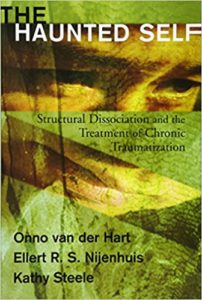The haunted self – structural dissociation and the treatment of chronic traumatization
by O. van der Hart, E. Nijenhuis, K. Steele

Written for: good DID therapists and those who want to become one, doctors whose job it is to recognize structural dissociation in patients
Special focus: structural dissociation
What it is not:
- written for patients
- easy to read, understand or accept.
- giving any practical advice for living with DID
- only about DID. It includes subtypes and also structural dissociation in cPTSD
- entertaining. It’s boring theory. But incredibly important.
- mentioning RA/MC with a single word
Language: General psychological terms will be used without being explained, while vocabulary that is essential to the theory will be explained in detail. It is worth learning these words because they can help you to express what you are experiencing. Translations into other languages are available (we saw french too)
Book: It is very logical, analytical and dispassionate, a well structured description that covers a lot of theory without repetition. There is no emotional warmth in this, but a lot of scientific zeal as the authors fight for a better understanding of DID among mental health professionals. I mention this because some could feel hurt by the lack of empathy. For others it might be the ideal way to learn.
Overview
(This book is 440 pages long, so I can just give you a very brief summary)
Part 1 Structural dissociation of the personality
- Explains the relationship of trauma and the theory of structural dissociation,
- introduces ANP and EP as basic parts and how action systems and memory are separated within the personality
- explains in great depth what primary, secondary and tertiary structural dissociation means and how to properly diagnose it using the DSM-V and ICD-10
- explains how other dissociative symptoms can be understood using the theory of structural dissociation, making diagnoses a lot clearer
- expresses concern about the lack of sharp definition of the word „dissociation“ since alterations of consciousness like depersonalisation/derealisation were included. This is important because it has to be treated differently!
- goes into great depth explaining how other trauma-related disorders can be understood as having a foundation of structural dissociation
- differential diagnosis, all of it described in detail
Part 2 Traumatization and a Janetian Psychology of Action
- describes how structural dissociation limits adaptive reactions to life, reaching goals, making sense of the world and our self
- how synthesis is needed to get more functional, taking the stigma out of integration, that seems to dominate the DID culture
- introduces the concept of realization, personification and presentification as path to counter structural dissociation and goes into great detail on how this is achieved. This orientation seems to make more sense than any approach we have seen before.
- the hierarchy of action tendencies, which can be helpful to assess individual parts and point out what to work on next.
- describes different phobias that maintain structural dissociation and how to approach them. These phobias are unique to structural dissociation and a T who never heard about it might miss it in treatment or get pulled into it by counter-transference.
Part 3 Treatment of chronically traumatized patients
- describes the difference between PTSD and complex trauma and the need to treat them differently.
- Assessment, including recommended testing and how to assess a dissociative system
- mental economy to increase daily functioning, an interesting approach we found very motivating
- Phase 1, in great depth, including a lot about attachment problems, avoidance of everything trauma-related including parts and emotions, the body etc. and how to deal with it
- Phase 2 and how to approach traumatic memory, in great detail, including mixed feelings about perpetrators
- Phase 3 regarding further integration, what that means and how to get there. One of the few books that actually share what should happen in this phase! More phobias that need to be overcome are explained in detail. Grief, sexuality, healthy risk taking etc and the end of therapy are subject here.
After reading
I was proud that I made it. It took me 5 times as long as other psych books.
„I am normal“ is what I kept thinking while reading. I am not an alien, especially difficult, actually not even special at all. It is just normal DID. I don’t look like what Hollywood makes me want to believe DID is. But I look exactly like it is described in this book. It was a great relief and helped me with my denial and doubt.
Then I wished that the people who have tried treating me without success would have read this. I would have made sense to them. They would have understood what they are seeing. It could have spared everyone a lot of trouble.
This book should be mandatory literature for any mental health professional responsible for diagnosing anyone who was traumatized. It’s the theory that builds the foundation of all good DID therapy.
The book certainly describes a lot more than a patient has to know. But I want to know it. Because I want to be able to recognize bad therapy when I experience it. I want to be educated about how it should look like so that I can keep a critical eye on my therapist. It helps me to trust my T when I see that they have a proper understanding of what is going on inside of me.
I believe this book is invaluable.
Over the next year or so I will mix in a few articles on the theory of structural dissociation found in this book. I will make sure to share the essence of what is important for us patients. It is a rather difficult read and I want you to get proper education about dissociation on this blog.


Leave a Reply